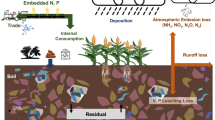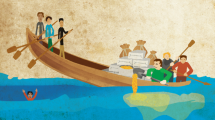Abstract
Agricultural trade and globalization pose new challenges for resource management and governance. In particular, many countries are dependent on imports of non-renewable mineral phosphorus (P) fertilizers for their agriculture. We propose a framework to assess the possible impacts of future disruptions in P resource availability by comparing countries’ P fertilizer use for export production (virtual P) to their existing domestic P resources (labile soil P stocks and phosphate rock reserves). We find that up to 26% of global P fertilizer use is linked to exported crop and livestock commodities, creating complex resource interdependencies across countries. Vulnerabilities to P resource shortage may be moderated by existing domestic P resources in some countries, which could mitigate either short- or long-term impacts of fertilizer trade disruptions. However, greater coordination among trade partners that acknowledges and manages multiple forms of mineral P interdependencies is needed to provide resilient access to P inputs for national food supplies globally.
This is a preview of subscription content, access via your institution
Access options
Access Nature and 54 other Nature Portfolio journals
Get Nature+, our best-value online-access subscription
$29.99 / 30 days
cancel any time
Subscribe to this journal
Receive 12 digital issues and online access to articles
$119.00 per year
only $9.92 per issue
Buy this article
- Purchase on Springer Link
- Instant access to full article PDF
Prices may be subject to local taxes which are calculated during checkout




Similar content being viewed by others
Data availability
Data are available in the respective Supplementary Data files. The R code used for computing all calculations is available at http://github.com/Pie90/SYSRISK/.
References
Nesme, T., Metson, G. S. & Bennett, E. M. Global phosphorus flows through agricultural trade. Glob. Environ. Change 50, 133–141 (2018).
Kastner, T., Erb, K. H. & Haberl, H. Rapid growth in agricultural trade: effects on global area efficiency and the role of management. Environ. Res. Lett. 9, 034015 (2014).
Puma, M. J., Bose, S., Chon, S. Y. & Cook, B. I. Assessing the evolving fragility of the global food system. Environ. Res. Lett. 10, 024007 (2015).
Bernard de Raymond, A. et al. Systemic risk and food security. Emerging trends and future avenues for research. Glob. Food Sec. 29, 100547 (2021).
Nesme, T., Roques, S., Metson, G. S. & Bennett, E. M. The surprisingly small but increasing role of international agricultural trade on the European Union’s dependence on mineral phosphorus fertiliser. Environ. Res. Lett. 11, 025003 (2016).
Liu, J. et al. Framing sustainability in a telecoupled world. Ecol. Soc. 18, 26 (2013).
Rosa, L., Chiarelli, D. D., Tu, C., Rulli, M. C. & D’Odorico, P. Global unsustainable virtual water flows in agricultural trade. Environ. Res. Lett. https://doi.org/10.1088/1748-9326/ab4bfc (2019).
D’Odorico, P. et al. Global virtual water trade and the hydrological cycle: patterns, drivers, and socio-environmental impacts. Environ. Res. Lett. 14, 053001 (2019).
Marchand, P. et al. Reserves and trade jointly determine exposure to food supply shocks. Environ. Res. Lett. 11, 095009 (2016).
Tu, C., Suweis, S. & D’Odorico, P. Impact of globalization on the resilience and sustainability of natural resources. Nat. Sustain 2, 283–289 (2019).
Mineral Commodity Summaries 2019 (USGS, 2019); https://doi.org/10.3133/70202434
Lun, F. et al. Influences of international agricultural trade on the global phosphorus cycle and its associated issues. Glob. Environ. Change 69, 102282 (2021).
Schipanski, M. E. & Bennett, E. M. The influence of agricultural trade and livestock production on the global phosphorus cycle. Ecosystems 15, 256–268 (2012).
Cordell, D. & Neset, T. S. S. Phosphorus vulnerability: a qualitative framework for assessing the vulnerability of national and regional food systems to the multi-dimensional stressors of phosphorus scarcity. Glob. Environ. Change 24, 108–122 (2014).
Cordell, D. & White, S. Life’s bottleneck: sustaining the world’s phosphorus for a food secure future. Annu. Rev. Environ. Resour. 39, 161–188 (2014).
Smil, V. Phosphorus in the environment: natural flows and human interferences. Annu. Rev. Energy Environ. 25, 53–88 (2000).
Sattari, S. Z., Bouwman, A. F., Giller, K. E. & van Ittersum, M. K. Residual soil phosphorus as the missing piece in the global phosphorus crisis puzzle. Proc. Natl Acad. Sci. USA 109, 6348–6353 (2012).
Trimmer, J. T. & Guest, J. S. Recirculation of human-derived nutrients from cities to agriculture across six continents. Nat. Sustain. 1, 427–435 (2018).
FAOSTAT Statistics Database (FAO, 2019); http://www.fao.org/faostat/en/#data
Heffer, P., Gruère, A. & Roberts, T. Assessment of Fertilizer Use by Crop at the Global Level (IFA, 2017).
Ringeval, B. et al. Phosphorus in agricultural soils: drivers of its distribution at the global scale. Glob. Change Biol. 23, 3418–3432 (2017).
MacDonald, G. K. et al. Rethinking agricultural trade relationships in an era of globalization. BioScience 65, 275–289 (2015).
Ordway, E. M., Asner, G. P. & Lambin, E. F. Deforestation risk due to commodity crop expansion in sub-Saharan Africa. Environ. Res. Lett. 12, 044015 (2017).
Cassidy, E. S., West, P. C., Gerber, J. S. & Foley, J. A. Redefining agricultural yields: from tonnes to people nourished per hectare. Environ. Res. Lett. 8, 034015 (2013).
Zeev, M. Preferential attachment, homophily, and the structure of international networks, 1816–2003. Confl. Manage. Peace Sci. 29, 341–369 (2012).
Le Noe, J. et al. The phosphorus legacy offers opportunities for agro ecological transition (France 1850-2075). Environ. Res. Lett. https://doi.org/10.1088/1748-9326/ab82cc (2020).
Mueller, N. D. et al. Closing yield gaps through nutrient and water management. Nature 490, 254–257 (2012).
Lun, F. et al. Global and regional phosphorus budgets in agricultural systems and their implications for phosphorus-use efficiency. Earth Syst. Sci. Data https://doi.org/10.5194/essd-10-1-2018 (2018).
Van Vuuren, D. P., Bouwman, A. F. & Beusen, A. H. W. Phosphorus demand for the 1970–2100 period: a scenario analysis of resource depletion. Glob. Environ. Change 20, 428–439 (2010).
Elser, J. J., Elser, T. J., Carpenter, S. R. & Brock, W. A. Regime shift in fertilizer commodities indicates more turbulence ahead for food security. PLoS ONE 9, e93998 (2014).
Headey, D. Rethinking the global food crisis: the role of trade shocks. Food Policy 36, 136–146 (2011).
Rosen, J. Humanity is flushing away one of life’s essential elements. The Atlantic (8 February 2021).
Risks and Opportunities in the Global Phosphate Rock Market (The Hague Centre for Strategic Studies, 2012).
The Global Fertiliser Crises and Africa (Future Agricultures, 2008).
Tamea, S., Laio, F. & Ridolfi, L. Global effects of local food-production crises: a virtual water perspective. Sci. Rep. 6, 18803 (2016).
Yang, X. & Post, W. M. Phosphorus transformations as a function of pedogenesis: a synthesis of soil phosphorus data using Hedley fractionation method. Biogeosciences 8, 2907–2916 (2011).
Menezes-Blackburn, D. et al. Opportunities for mobilizing recalcitrant phosphorus from agricultural soils: a review. Plant Soil 427, 5–16 (2018).
Roy, E. D. et al. The phosphorus cost of agricultural intensification in the tropics. Nat. Plants 2, 16043 (2016).
Chen, M. & Graedel, T. E. A half-century of global phosphorus flows, stocks, production, consumption, recycling, and environmental impacts. Glob. Environ. Change 36, 139–152 (2016).
Brownlie, W. J. et al. Global actions for a sustainable phosphorus future. Nat. Food 2, 71–74 (2021).
Sharpley, A., Kleinman, P., Jarvie, H. & Flaten, D. Distant views and local realities: the limits of global assessments to restore the fragmented phosphorus cycle. Agric. Environ. Lett. 1, 160024 (2016).
Van Drecht, G., Bouwman, A. F., Harrison, J. & Knoop, J. M. Global nitrogen and phosphate in urban wastewater for the period 1970 to 2050. Glob. Biogeochem. Cycles 23, GB0A03 (2009).
Tonini, D., Saveyn, H. G. M. & Huygens, D. Environmental and health co-benefits for advanced phosphorus recovery. Nat. Sustain. 2, 1051–1061 (2019).
Nesme, T., Senthilkumar, K., Mollier, A. & Pellerin, S. Effects of crop and livestock segregation on phosphorus resource use: a systematic, regional analysis. Eur. J. Agron. 71, 88–95 (2015).
Grote, U., Craswell, E. & Vlek, P. Nutrient flows in international trade: ecology and policy issues. Environ. Sci. Policy 8, 439–451 (2005).
Hamilton, H. A. et al. Trade and the role of non-food commodities for global eutrophication. Nat. Sustain. 1, 314–321 (2018).
Kastner, T., Kastner, M. & Nonhebel, S. Tracing distant environmental impacts of agricultural products from a consumer perspective. Ecol. Econ. 70, 1032–1040 (2011).
Herrero, M. et al. Biomass use, production, feed efficiencies, and greenhouse gas emissions from global livestock systems. Proc. Natl Acad. Sci. USA 110, 20888–20893 (2013).
Sheldrick, W., Syers, J. K. & Lingard, J. Contribution of livestock excreta to nutrient balances. Nutr. Cycl. Agroecosyst. 66, 119–131 (2003).
Yunju, L. et al. Fertilizer use patterns in Yunnan Province, China: implications for agricultural and environmental policy. Agric. Syst. 110, 78–89 (2012).
Nesme, T., Bellon, S., Lescourret, F., Senoussi, R. & Habib, R. Are agronomic models useful for studying farmers’ fertilisation practices? Agric. Syst. 83, 297–314 (2005).
Yang, Y. & Suh, S. Changes in environmental impacts of major crops in the US. Environ. Res. Lett. 10, 094016 (2015).
Author information
Authors and Affiliations
Contributions
P.B., T.N. and A.B.d.R. conceived the study. G.K.M and P.B developed the conceptual framework and the country classification. P.B. conducted all data analysis and calculations. All authors were involved in the interpretation of the results and contributed in writing and revising the manuscript.
Corresponding author
Ethics declarations
Competing interests
The authors declare no competing interests.
Additional information
Peer review information Nature Sustainability thanks Thomas Kastner, Kazuyo Matsubae and the other, anonymous, reviewer(s) for their contribution to the peer review of this work.
Publisher’s note Springer Nature remains neutral with regard to jurisdictional claims in published maps and institutional affiliations.
Supplementary information
Supplementary Information
Supplementary Figs. 1–4, Tables 1–7, Methods and references.
Supplementary Data 1
This dataset contains the list of the 138 items retained for the analyses as well as all coefficients used in the calculations.
Supplementary Data 2
This dataset contains the share of grain-based feed necessary for one animal based on the use of eight main crop species.
Supplementary Data 3
This dataset contains the fertilization rates for each of the 163 countries considered in the paper and for each crop species or crop category.
Supplementary Data 4
This dataset contains the virtual P exports, soil P stocks and PR reserves for each of the 163 countries considered in this study.
Supplementary Data 5
This dataset contains (1) the raw IFA data on P fertilizer application for all available countries and crops, (2) the harvested area as retrieved from FAOSTAT in July 2019, and (3) the respective calculation of P fertilizer rate per hectare of cropland.
Rights and permissions
About this article
Cite this article
Barbieri, P., MacDonald, G.K., Bernard de Raymond, A. et al. Food system resilience to phosphorus shortages on a telecoupled planet. Nat Sustain 5, 114–122 (2022). https://doi.org/10.1038/s41893-021-00816-1
Received:
Accepted:
Published:
Issue Date:
DOI: https://doi.org/10.1038/s41893-021-00816-1
This article is cited by
-
Decreasing resilience of China’s coupled nitrogen–phosphorus cycling network requires urgent action
Nature Food (2024)
-
Phosphorus limitation of Pinus massoniana reforestation increases with stand development: evidence from plant, leaf litter, and soil
Plant and Soil (2024)
-
A review of socio-metabolic research on circularity in agri-food systems and pathways to action
Nutrient Cycling in Agroecosystems (2024)
-
Agricultural trade impacts global phosphorus use and partial productivity
Nature Food (2023)
-
Half of global agricultural soil phosphorus fertility derived from anthropogenic sources
Nature Geoscience (2023)



